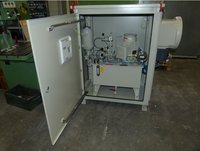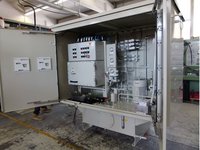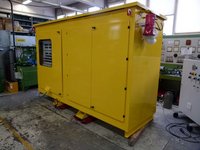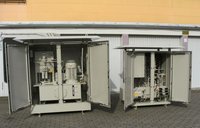Safe Liquid Gas Transfer from Ship to Ship - High-Tech Hydraulics, Made in Bavaria
 ATEX Certificate as PDF
ATEX Certificate as PDF
ATEX refers to EU directives on explosion protection (ATmosphères EXplosibles) from 2014 and 1999, which focus on the safe handling of explosive atmospheres. The primary emphasis is on the protection and safety of workers who handle explosive materials and equipment.
We are certified to inspect and adjust systems according to this essential requirement. Our main focus is on securing explosive atmospheres and preventing damage. We adhere strictly to the following specifications:
Customer- and country-specific versions of systems for explosive atmospheres
Explosion protection according to:
- Mechanical ATEX (Certification up to Ex II 2GD cbk T3)
- NEC 500 (Construction of units with control up to Class 1, Division 2)
- NEC 505 (Construction of units with control up to Class 1, Zone 1)
- IECEx (Construction of units with control up to Zone 1, IIC, T4)
These four guidelines are internationally recognized standards from the EU, the USA, and the IEC (International Electrotechnical Commission, a global organization that develops and publishes international standards for electrical engineering). We strive for strict adherence and verification to ensure safe and reliable production even in explosive atmospheres.
Country-specific regulations
- EU Machinery Directive 2006/42/EC
- UL (Underwriters Laboratories)
- CSA/CEC (Canadian Standards Association/Canadian Electrical Code)
- EAC (Eurasian Conformity)
- …
In addition to adhering to international explosion protection standards, we also emphasize compliance with regional and international regulations concerning machinery construction. These regulations not only ensure quality but also help prevent deficiencies that could contribute to explosion hazards. The key standards are represented by those from the EU, the USA, Canada, Russia, and Central Asia. However, we place great importance on fulfilling all other relevant regulations for your project as well.
Relevant key data
from -40°C to +55°C
Maximum ambient temperature:
Hydraulic unit with the following specifications:
Pmax=35 kW or
Qmax= 200,0 l/min or
pmax=2500 bar
Maximum performance data:
up to 2500 l
Maximum oil reservoir volume:
Configuration according to safety requirements
- EN 62061: Safety of machinery - Functional safety of safety-related electrical, electronic, and programmable electronic control systems
- EN 13849: Safety of machinery - Safety-related parts of control systems
Additional certifications
- Intertek / TÜV
- Shipbuilding approvals
- BUREAU VERITAS
- Germanischer Lloyd
Once the safety regulations are met, we don’t stop there. We go a step further, providing quality assurance that will set you apart from your competitors through years of experience and expertise.
our specialists
Do you have questions about explosion protection? Contact our
Examples of different scales and designs of explosion protection systems:
Small unit
- Small unit integrated into a stainless steel compact housing 1.4301
- with attached Ex-de (ib) IIB T3 enclosure (design according to IEC 60079)
- Performance data: Pump: P = 1.5 kW; Q = 3.7 l/min; pmax = 115 bar
- Ambient temperature: from -20°C to +55°C
- Installation location: UAE
- Reservoir volume: 70 l

Hydraulic unit with attached control cabinet
- Control Cabinet: Stainless steel 1.4301
- Explosion Protection: ATEX Zone 1, IIB, T3
- Ambient Temperature: -14°C to +37°C
- Installation Location: France
- Pump: P = 7.5 kW; Q = 16.0 l/min; pmax = 190 bar
- Reservoir Volume: 250 l
- 1 x 10 l bladder accumulator for safety functions
- Electrical Control: Designed according to EN 60079
- Operating and Indicator Elements: Integrated in Ex-e enclosure
- Enclosure Material: Aluminum die-cast / painted steel sheet
- Steuerung:
- Control: Safety-oriented Siemens S7-315F-DP/PN PLC
- Customer Connection: via ProfiNET and with signaling contacts
- Wireless Remote Control
- Wired Remote Control
- Acoustic Alarm for Faults
- LED Flashing Lights for Faults and Status Updates
- Electrical Oil Level Monitoring
- Electrical Oil Temperature Monitoring
- Proportional Valve for Speed Control
- Directional Valves for Movement and Safety Function Control

Hydraulic unit in complete enclosure
- Complete Enclosure: Stainless steel 1.4301
- Explosion Protection: IECEx Zone 1, IIB, T3
- Ambient Temperature: -20°C to +42°C
- Installation Location: Venezuela
- Pump: P = 11 kW; Q = 18.0 l/min; pmax = 190 bar
- Reservoir Volume: 250 l
- 2 x 15 l bladder accumulators for safety functions
- Electrical Control: Designed according to IEC 60079
- Operating and Indicator Elements: Integrated in Ex-e enclosure
- Enclosure Material: Aluminum die-cast / painted steel sheet
- Control: Siemens S7-315-DP PLC with decentralized Siemens ISP peripheral
- Customer Connection: via signaling contacts
- Wireless Remote Control
- Wired Remote Control
- Acoustic Alarm for Faults
- LED Flashing Lights for Faults and Status Updates
- Electrical Oil Level Monitoring
- Electrical Oil Temperature Monitoring
- Directional Valves for Speed Control
- Directional Valves for Movement and Safety Function Control

Hydraulic unit with external valve assembly and external accumulator
- Complete Enclosure: Stainless steel 1.4301
- Explosion Protection: ATEX Zone 1, IIB, T3
- Ambient Temperature: -20°C to +54°C
- Installation Location: Pakistan
- Pump: P = 15 kW; Q = 29.5 l/min; pmax = 180 bar
- Reservoir Volume: 300 l
- 1 x 125 l piston accumulator for safety functions
- Electrical Control: Designed according to EN 60079
- Operating and Indicator Elements: Integrated in Ex-e enclosure
- Enclosure Material: Aluminum die-cast / painted steel sheet
- Control: Safety-oriented Siemens S7-315F-DP PLC
- Customer Connection: via Modbus RTU and signaling contacts
- Wireless Remote Control
- Wired Remote Control
- Acoustic Alarm for Faults
- LED Flashing Lights for Faults and Status Updates
- Electrical Oil Level Monitoring
- Electrical Oil Temperature Monitoring
- Directional Valves for Speed Control
- Directional Valves for Movement and Safety Function Control


 ATEX Certificate as PDF
ATEX Certificate as PDF